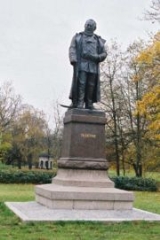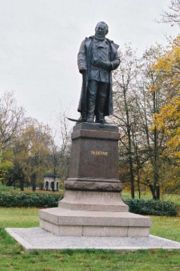
Karl Heine
Encyclopedia
Ernst Karl Erdmann Heine (January 10, 1819 – August 25, 1888) was a lawyer
in Leipzig and a major entrepreneur
and industrial pioneer who shaped the face of the western suburbs of Leipzig.
 Karl Heine was born in Leipzig
Karl Heine was born in Leipzig
, to the owner of Neuscherbitz Estate, Johann Carl Friedrich Heine, and his wife Christiana Dorothea, née Reichel (1781–1857). He attended the Thomasschule zu Leipzig
, a public boarding school in Leipzig. Later he studied law at the University of Leipzig
- he was member of the Corps Saxonia Leipzig fraternity. He received a doctorate
on the economic use of waterways and shores according to Saxon state law. Then he established himself in Leipzig as a barrister.
After the death of his grandfather E.T. Reichel (1748–1832), Karl Heine bought the shares of Reichel's Garden from another heir, took these parcels of land and from the middle of the 19th century on, he gradually built what is today the inner western suburb of Leipzig.
In 1854, Heine also expanded his estate in the Gemeinde Plagwitz district of Leipzig; in 1856, he began the construction of the first section of a navigable canal connecting the rivers Weisse Elster and Saale
, which today bears his name (Karl-Heine-Kanal). The excavation of the canal reclaimed what was later to become the western suburb of Leipzig. To institute his plans for construction and industrialization, Heine established an "economy" in Plagwitz.
When the western suburb was connected to Gemeinde Plagwitz, Heine constructed the Plagwitzer Straße (today named Käthe-Kollwitz-Straße), a street to the south of the old highway from Leipzig to Lindenau, which ran parallel to the new street. Against the opposition of the Leipzig council, he also built the Plagwitz bridge, which connected to the Leipziger Straße in Plagwitz (today: Karl-Heine-Straße).
Karl Heine was a member of the Saxon Diet from 1870 to his death. He was also a representative in the Leipzig city council.
In 1874, he moved into his newly built villa in Neuschleußig (Karl-Heine-Villa, Könneritzstraße 1), where he dwelled until his death.
In 1876, a construction scheme was approved which encompassed merging Karl Heine's meadows and fields in the northern part of Schleußig (Neuschleußig) with Bernhard Hüffer's (1824–1904) estate and extensive undeveloped forest land. These areas would be designated new residential areas.
On May 24, 1888, Heine founded the Westend-Baugesellschaft, a construction company, to continue his work in developing the Leipzig economy after his death.
Since 1854, Karl Heine had also been a member of the Leipzig masonic lodge
Apollo. He died on August 25, 1888, aged 69, in Leipzig.
In 2003, a Leipzig vocational school adopted the name of Karl-Heine-Schule.
Lawyer
A lawyer, according to Black's Law Dictionary, is "a person learned in the law; as an attorney, counsel or solicitor; a person who is practicing law." Law is the system of rules of conduct established by the sovereign government of a society to correct wrongs, maintain the stability of political...
in Leipzig and a major entrepreneur
Entrepreneur
An entrepreneur is an owner or manager of a business enterprise who makes money through risk and initiative.The term was originally a loanword from French and was first defined by the Irish-French economist Richard Cantillon. Entrepreneur in English is a term applied to a person who is willing to...
and industrial pioneer who shaped the face of the western suburbs of Leipzig.
Life

Leipzig
Leipzig Leipzig has always been a trade city, situated during the time of the Holy Roman Empire at the intersection of the Via Regia and Via Imperii, two important trade routes. At one time, Leipzig was one of the major European centres of learning and culture in fields such as music and publishing...
, to the owner of Neuscherbitz Estate, Johann Carl Friedrich Heine, and his wife Christiana Dorothea, née Reichel (1781–1857). He attended the Thomasschule zu Leipzig
Thomasschule zu Leipzig
St. Thomas School, Leipzig is a co-educational and public boarding school in Leipzig, Saxony, Germany. It was founded by the Augustinians in 1212 and is one of the oldest schools in the world.St. Thomas is known for its art, language and music education...
, a public boarding school in Leipzig. Later he studied law at the University of Leipzig
University of Leipzig
The University of Leipzig , located in Leipzig in the Free State of Saxony, Germany, is one of the oldest universities in the world and the second-oldest university in Germany...
- he was member of the Corps Saxonia Leipzig fraternity. He received a doctorate
Doctorate
A doctorate is an academic degree or professional degree that in most countries refers to a class of degrees which qualify the holder to teach in a specific field, A doctorate is an academic degree or professional degree that in most countries refers to a class of degrees which qualify the holder...
on the economic use of waterways and shores according to Saxon state law. Then he established himself in Leipzig as a barrister.
After the death of his grandfather E.T. Reichel (1748–1832), Karl Heine bought the shares of Reichel's Garden from another heir, took these parcels of land and from the middle of the 19th century on, he gradually built what is today the inner western suburb of Leipzig.
In 1854, Heine also expanded his estate in the Gemeinde Plagwitz district of Leipzig; in 1856, he began the construction of the first section of a navigable canal connecting the rivers Weisse Elster and Saale
Saale
The Saale, also known as the Saxon Saale and Thuringian Saale , is a river in Germany and a left-bank tributary of the Elbe. It is not to be confused with the smaller Franconian Saale, a right-bank tributary of the Main, or the Saale in Lower Saxony, a tributary of the Leine.-Course:The Saale...
, which today bears his name (Karl-Heine-Kanal). The excavation of the canal reclaimed what was later to become the western suburb of Leipzig. To institute his plans for construction and industrialization, Heine established an "economy" in Plagwitz.
When the western suburb was connected to Gemeinde Plagwitz, Heine constructed the Plagwitzer Straße (today named Käthe-Kollwitz-Straße), a street to the south of the old highway from Leipzig to Lindenau, which ran parallel to the new street. Against the opposition of the Leipzig council, he also built the Plagwitz bridge, which connected to the Leipziger Straße in Plagwitz (today: Karl-Heine-Straße).
Karl Heine was a member of the Saxon Diet from 1870 to his death. He was also a representative in the Leipzig city council.
In 1874, he moved into his newly built villa in Neuschleußig (Karl-Heine-Villa, Könneritzstraße 1), where he dwelled until his death.
In 1876, a construction scheme was approved which encompassed merging Karl Heine's meadows and fields in the northern part of Schleußig (Neuschleußig) with Bernhard Hüffer's (1824–1904) estate and extensive undeveloped forest land. These areas would be designated new residential areas.
On May 24, 1888, Heine founded the Westend-Baugesellschaft, a construction company, to continue his work in developing the Leipzig economy after his death.
Since 1854, Karl Heine had also been a member of the Leipzig masonic lodge
Masonic Lodge
This article is about the Masonic term for a membership group. For buildings named Masonic Lodge, see Masonic Lodge A Masonic Lodge, often termed a Private Lodge or Constituent Lodge, is the basic organisation of Freemasonry...
Apollo. He died on August 25, 1888, aged 69, in Leipzig.
Honours
In 1897, the city of Leipzig honoured Karl Heine with a monument. The monument was melted down in the Second World War, but newly constructed in 2001. There are numerous streets and one plaza named after him. (Erdmannstraße, 1891; Karl-Heine-Straße, 1904; Karl-Heine-Platz, et al.)In 2003, a Leipzig vocational school adopted the name of Karl-Heine-Schule.

